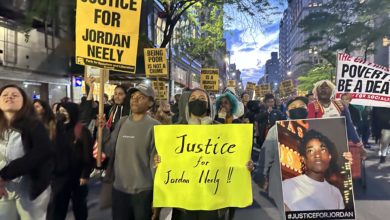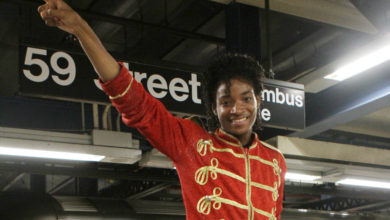On April 28, an overflow crowd packed a coffee shop screening of “Battle for Whiteclay,” hosted by the South Dakota ANSWER Coalition (Act Now to Stop War and End Racism). The film documents the struggle of the residents of the Pine Ridge Indian Reservation in South Dakota and their allies to shut down four predatory liquor stores across the border in Whiteclay, Neb. It features Native American activists Frank LaMere, Duane Martin, Sr. and Russell Means.
Alcohol has been banned on Pine Ridge since the 1970s because of its crippling effect on residents of the reservation. Whiteclay is an unincorporated town of 14 people located just 200 feet from the reservation border and in walking distance from the reservation’s biggest town. The town as no public services, but four liquor stores there sell the equivalent of 4.5 million 12-ounce cans of beer annually, mainly to the Native American residents of Pine Ridge. That’s 12,500 cans per day.
Filmmaker Mark Vasina, who led the discussion at the film showing, told PSL, “Whitelay is important because it’s a glaring example, it’s the poster child, for exploitation of the reservation by border towns.”
Whiteclay is known as “the skid row of the prairie.” As the film documents, the misery of alcoholism is on display day and night in this small town, where public drunkenness is pervasive. The liquor establishments continually violate liquor license regulations by selling alcohol to minors, selling to visibly intoxicated people, allowing alcohol consumption on the premises and trading alcohol for sex.
Lyle Jack, Oglala Sioux Tribal Council member, describes the situation in the film: “They know alcohol is banned here, yet they set up right on the outskirts of the reservation. And they prey upon our people and their sicknesses, this disease that has affected them. They make millions of dollars off our people, yet they do not contribute anything back. … Unfortunately, for a lot of our people there’s no way out, because the tribe does not have the funding or the resources to set up our own treatment centers to help them.”
Citations of these violations could easily shut the liquor stores down, yet law enforcement is conspicuously lacking in the area. The liquor control commission has failed to act against the businesses, so they continue to operate freely, even though they are selling to people who have no legal place to consume the alcohol. The state of Nebraska receives sizable tax income from the Whiteclay liquor sales. Business interests, including the National Beverage Association, have rallied to thwart legislative efforts to address the problem.
The situation is a clear demonstration that there is one standard for the majority white population in Nebraska and another for Native Americans. “It’s a broader issue than the alcohol—it’s the disregard for health and safety and disrespect of the Native population on Pine Ridge. [Whiteclay] only operates with elected officials and law enforcement looking the other way, all along the chain of command from the local to the county to the state level,” said Vasina.
Conditions on Pine Ridge
Pine Ridge has a long history of oppression and struggle against oppression. It is home to the site of the 1890 Wounded Knee massacre, which was later the site of the American Indian Movement standoff with FBI agents, for which political prisoner Leonard Peltier is still being held.
A 2006 Special Resource Report by Stephanie Schwartz of the Native American Journalists Association reveals shocking statistics about the difficulty of life on Pine Ridge. The tribe estimates that 40,000 people live on Pine Ridge. Median income is between $2,600 and $3,500 per year, with 97 percent of the population living below the federal poverty level. The average family home has an estimated 17 people squeezed into it. Thirty-nine percent of the homes have no electricity, in a climate with extremes of cold and heat.
There is little industry or commercial infrastructure on the reservation, and as a result, the unemployment rate is soaring at 83-85 percent.
Life expectancy for men is 48 years and for women is 52. Infant mortality is the highest on the continent, 300 percent higher than the U.S. average. The school dropout rate is over 70 percent and the teenage suicide rate is 150 percent of the national average. Over half of the population over 40 suffers from diabetes, 800 percent higher than the U.S. average.
Alongside and as a result of these desperate conditions, alcoholism affects eight out of 10 families on Pine Ridge. The tribal leadership has banned alcohol from the reservation, but the town of Whiteclay has continued to fuel the problem.
United States breaks treaty
Pine Ridge reservation was originally part of the 60 million acres of land designated by the Fort Laramie Treaty of 1868 to belong to the Greater Lakota Nation. But in 1876, the U.S. government violated the treaty and opened up much of this land to homesteaders and private interests, including the sacred land of the Black Hills. What remained was divided up into several smaller reservations across South Dakota.
After illegal whiskey bootleggers from Nebraska preyed on the Pine Ridge reservation, the U.S. government established a 50-mile buffer zone south of the reservation for its protection. But in 1904, President Theodore Roosevelt effectively reversed this order, over the protests of the Oglala Lakota elders, and the border town of Whiteclay was born.
Struggle for self-determination
The land on which Whiteclay sits is still disputed by the tribe. The Oglala Lakota Nation and its allies have continued their fight, using various tactics to try to shut down the source of the alcohol that afflicts their people. The tribe has fought for increased law enforcement, not against their people but against the businesses that continue to violate liquor sale regulations on a regular basis. So far, they have managed to pass state legislation that would prohibit new liquor licenses from being approved, but they are still struggling to get the existing businesses shut down.
Starting in 2006, tribal members have attempted an annual road blockade to stop alcohol from entering the reservation. Protesters have marched on the capital and also picketed a Nebraska beer wholesaler that supplies Whiteclay. The film “Battle for Whiteclay” has raised controversy and awareness about the struggle across Nebraska. Filmmaker Vasina, who is an organizer with Nebraskans for Peace, said, “Whiteclay continues to operate for three reasons: money, racism and apathy.” The ANSWER coalition pledged to help raise awareness and build solidarity to help overcome these obstacles and win justice for the reservation. ANSWER will host a second screening next week.
For more information or to order a copy of the film, go to www.BattleforWhiteclay.org






